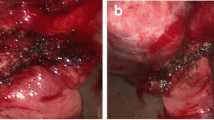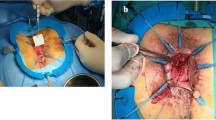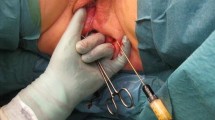Abstract
Background
A rectovaginal fistula (RVF) is a debilitating condition that is difficult to treat. Many available techniques are invasive and involve extensive surgery. A local procedure with good closure rates would be preferable as a first step in the treatment of RVF. The aim of this study was the development of a local technique for the closure of RVF with good closure rates to prevent the use of more invasive procedures.
Methods
This was a pilot study. Patients with RVF who had undergone multiple operations in the pelvic area, local radiotherapy, chemotherapy or had been diagnosed with Crohn’s disease were included in the study. All had a history of surgery for RVF. A cross-linked collagen matrix biomesh was placed in the rectovaginal septum using a transperineal or a transvaginal approach. The main outcome measure in this study was the closure rate reported as absence of the fistula at 1 year.
Results
Twelve patients were included in the study. Absence of fistula at 1 year was 0.64 (95 % confidence interval 0.30–0.85). Three patients (25.0 %) developed a recurrence, two were reoperated on with a gracilis flap transposition, and one was treated with laparoscopic ligation. In one patient (8.3 %), the fistula failed to close within 3 months after the mesh placement.
Conclusions
Our technique shows promising results. A local and simple technique with acceptable closure and morbidity rates, like our local repair with biomesh, would be ideal as a first step in treating RVFs. Long-term results are needed.




Similar content being viewed by others
References
El-Gazzaz G, Hull TL, Mignanelli E, Hammel J, Gurland B, Zutshi M (2010) Obstetric and cryptoglandular rectovaginal fistulas: long-term surgical outcome; quality of life; and sexual function. J Gastrointest Surg 14:1758–1763
Cardon A, Pattyn P, Monstrey S, Hesse U, de Hemptinne B (1999) Use of a unilateral pudendal thigh flap in the treatment of complex rectovaginal fistula. Br J Surg 86:645–646
Kosugi C, Saito N, Kimata Y et al (2005) Rectovaginal fistulas after rectal cancer surgery: incidence and operative repair by gluteal-fold flap repair. Surgery 137:329–336
Oom DM, Gosselink MP, Van Dijl VR, Zimmerman DD, Schouten WR (2006) Puborectal sling interposition for the treatment of rectovaginal fistulas. Tech Coloproctol 10:125–130; discussion 130
Cui L, Chen D, Chen W, Jiang H (2009) Interposition of vital bulbocavernosus graft in the treatment of both simple and recurrent rectovaginal fistulas. Int J Colorectal Dis 24:1255–1259
Lefevre JH, Bretagnol F, Maggiori L, Alves A, Ferron M, Panis Y (2009) Operative results and quality of life after gracilis muscle transposition for recurrent rectovaginal fistula. Dis Colon Rectum 52:1290–1295
Pitel S, Lefevre JH, Parc Y, Chafai N, Shields C, Tiret E (2011) Martius advancement flap for low rectovaginal fistula: short- and long-term results. Colorectal Dis 13:e112–e115
van der Hagen SJ, Soeters PB, Baeten CG, van Gemert WG (2011) Laparoscopic fistula excision and omentoplasty for high rectovaginal fistulas: a prospective study of 40 patients. Int J Colorectal Dis 26:1463–1467
Li Destri G, Scilletta B, Tomaselli TG, Zarbo G (2008) Rectovaginal fistula: a new approach by stapled transanal rectal resection. J Gastrointest Surg 12:601–603
Ortiz-Moyano C, Guerrero-Jimenez P, Romero-Gomez M (2011) Endoscopic closure of a rectovaginal fistula combining N-2-butyl-cyanoacrylate (Histoacryl) and Resolution clips. Endoscopy 43(Suppl 2 UCTN):E133–E134
D’Ambrosio G, Paganini AM, Guerrieri M et al (2012) Minimally invasive treatment of rectovaginal fistula. Surg Endosc 26:546–550
Jarrar A, Church J (2011) Advancement flap repair: a good option for complex anorectal fistulas. Dis Colon Rectum 54:1537–1541
Queralto M, Badiou W, Bonnaud G, Abramowitz L, Tanguy LGY, Monrozies X (2012) Vaginal flap for rectovaginal fistulae in Crohn’s disease. Gynecol Obstet Fertil 40:143–147
Gajsek U, McArthur DR, Sagar PM (2011) Long-term efficacy of the button fistula plug in the treatment of Ileal pouch-vaginal and Crohn’s-related rectovaginal fistulas. Dis Colon Rectum 54:999–1002
Athanasiadis S, Yazigi R, Kohler A, Helmes C (2007) Recovery rates and functional results after repair for rectovaginal fistula in Crohn’s disease: a comparison of different techniques. Int J Colorectal Dis 22:1051–1060
Ellis CN (2008) Outcomes after repair of rectovaginal fistulas using bioprosthetics. Dis Colon Rectum 51:1084–1088
Rodriguez-Wong U, Cruz-Reyes JM, Santamaria-Aguirre JR, Garcia-Alvarez J (2009) Postobstetric rectovaginal fistula: surgical treatment using endorectal advancement flap. Cir Cir 77:201–205 (Spanish)
de Parades V, Dahmani Z, Blanchard P, Zeitoun JD, Sultan S, Atienza P (2011) Endorectal advancement flap with muscular plication: a modified technique for rectovaginal fistula repair. Colorectal Dis 13:921–925
Rosen MJ (2010) Biologic mesh for abdominal wall reconstruction: a critical appraisal. Am Surg 76:1–6
Oliver RF, Grant RA, Cox RW, Hulme MJ, Mudie A (1976) Histological studies of subcutaneous and intraperitoneal implants of trypsin-prepared dermal collagen allografts in the rat. Clin Orthop Relat Res 115:291–302
Moore RD, Miklos JR, Kohli N (2004) Rectovaginal fistula repair using a porcine dermal graft. Obstet Gynecol 104:1165–1167
Pye PK, Dada T, Duthie G, Phillips K (2004) Surgisistrade mark mesh: a novel approach to repair of a recurrent rectovaginal fistula. Dis Colon Rectum 47:1554–1556
Schwandner O, Fuerst A, Kunstreich K, Scherer R (2009) Innovative technique for the closure of rectovaginal fistula using Surgisis mesh. Tech Coloproctol 13:135–140
Shelton AA, Welton ML (2006) Transperineal repair of persistent rectovaginal fistulas using an acellular cadaveric dermal graft (AlloDerm). Dis Colon Rectum 49:1454–1457
van den Aardweg GJ, Olofsen-van Acht MJ, van Hooije CM, Levendag PC (2003) Radiation-induced rectal complications are not influenced by age: a dose fractionation study in the rat. Radiat Res 159:642–650
Conflict of interest
None.
Author information
Authors and Affiliations
Corresponding author
Electronic supplementary material
Below is the link to the electronic supplementary material.
Supplementary material 1 (MPG 31,990 kb)
Supplementary material 2 (MPG 32,032 kb)
Supplementary material 3 (MPG 29,924 kb)
Rights and permissions
About this article
Cite this article
Göttgens, K.W.A., Heemskerk, J., van Gemert, W. et al. Rectovaginal fistula: a new technique and preliminary results using collagen matrix biomesh. Tech Coloproctol 18, 817–823 (2014). https://doi.org/10.1007/s10151-014-1145-9
Received:
Accepted:
Published:
Issue Date:
DOI: https://doi.org/10.1007/s10151-014-1145-9




